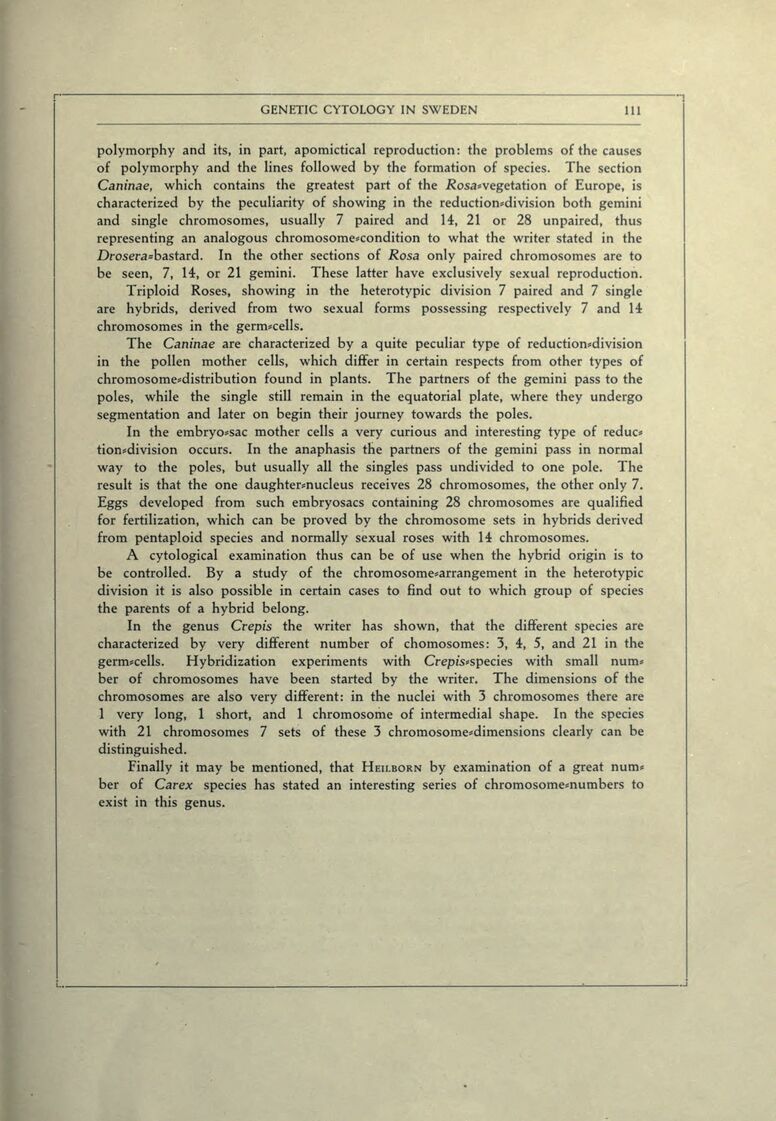
Full resolution (JPEG) - On this page / på denna sida - Part I - Professor Otto Rosenberg, Stockholm, Genetic Cytology in Sweden

<< prev. page << föreg. sida << >> nästa sida >> next page >>
Below is the raw OCR text
from the above scanned image.
Do you see an error? Proofread the page now!
Här nedan syns maskintolkade texten från faksimilbilden ovan.
Ser du något fel? Korrekturläs sidan nu!
This page has never been proofread. / Denna sida har aldrig korrekturlästs.
polymorphy and its, in part, apomictical reproduction: the problems of the causes
of polymorphy and the lines followed by the formation of species. The section
Caninae, which contains the greatest part of the i?osa*vegetation of Europe, is
characterized by the peculiarity of showing in the reductiomdivision both gemini
and single chromosomes, usually 7 paired and 14, 21 or 28 unpaired, thus
representing an analogous chromosome=condition to what the writer stated in the
T)rosera=bastard. In the other sections of Rosa only paired chromosomes are to
be seen, 7, 14, or 21 gemini. These latter have exclusively sexual reproduction.
Triploid Roses, showing in the heterotypic division 7 paired and 7 single
are hybrids, derived from two sexual forms possessing respectively 7 and 14
chromosomes in the germ*cells.
The Caninae are characterized by a quite peculiar type of reductiomdivision
in the pollen mother cells, which differ in certain respects from other types of
chromosomesdistribution found in plants. The partners of the gemini pass to the
poles, while the single still remain in the equatorial plate, where they undergo
segmentation and later on begin their journey towards the poles.
In the embryossac mother cells a very curious and interesting type of reduc*
tion=division occurs. In the anaphasis the partners of the gemini pass in normal
way to the poles, but usually all the singles pass undivided to one pole. The
result is that the one daughtermucleus receives 28 chromosomes, the other only 7.
Eggs developed from such embryosacs containing 28 chromosomes are qualified
for fertilization, which can be proved by the chromosome sets in hybrids derived
from pentaploid species and normally sexual roses with 14 chromosomes.
A cytological examination thus can be of use when the hybrid origin is to
be controlled. By a study of the chromosome*arrangement in the heterotypic
division it is also possible in certain cases to find out to which group of species
the parents of a hybrid belong.
In the genus Crepis the writer has shown, that the different species are
characterized by very different number of chomosomes: 3, 4, 5, and 21 in the
gerrmcells. Hybridization experiments with Crepis=>species with small num<
ber of chromosomes have been started by the writer. The dimensions of the
chromosomes are also very different: in the nuclei with 3 chromosomes there are
1 very long, 1 short, and 1 chromosome of intermedial shape. In the species
with 21 chromosomes 7 sets of these 3 chromosome^dimensions clearly can be
distinguished.
Finally it may be mentioned, that Heilborn by examination of a great num*
ber of Carex species has stated an interesting series of chromosome=numbers to
exist in this genus.
<< prev. page << föreg. sida << >> nästa sida >> next page >>